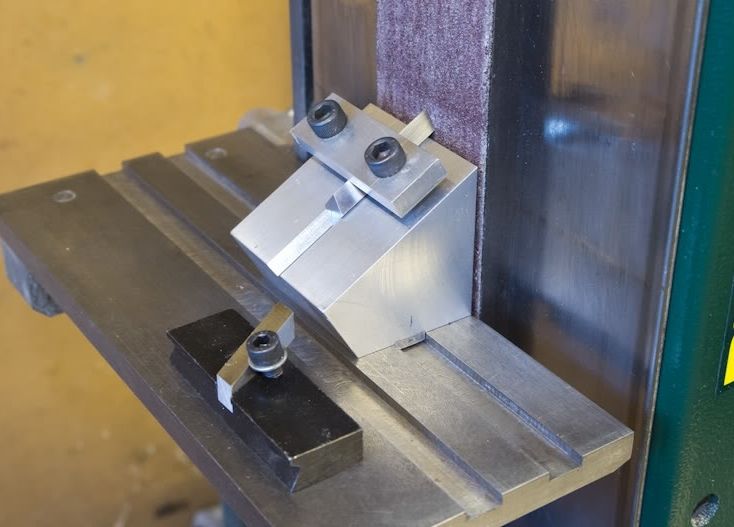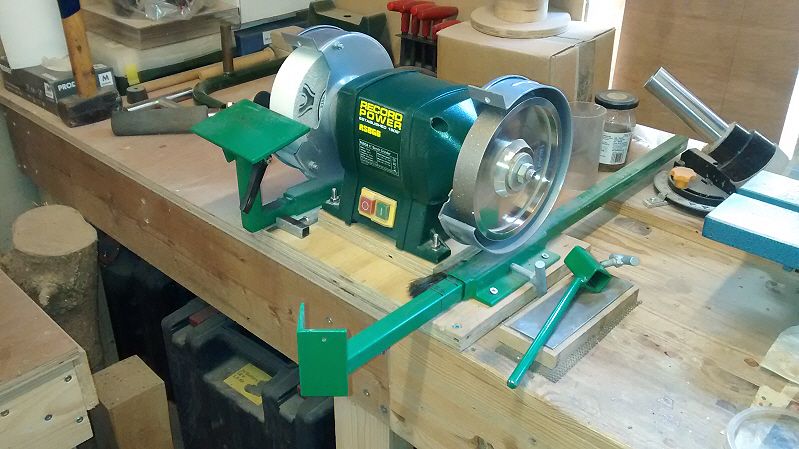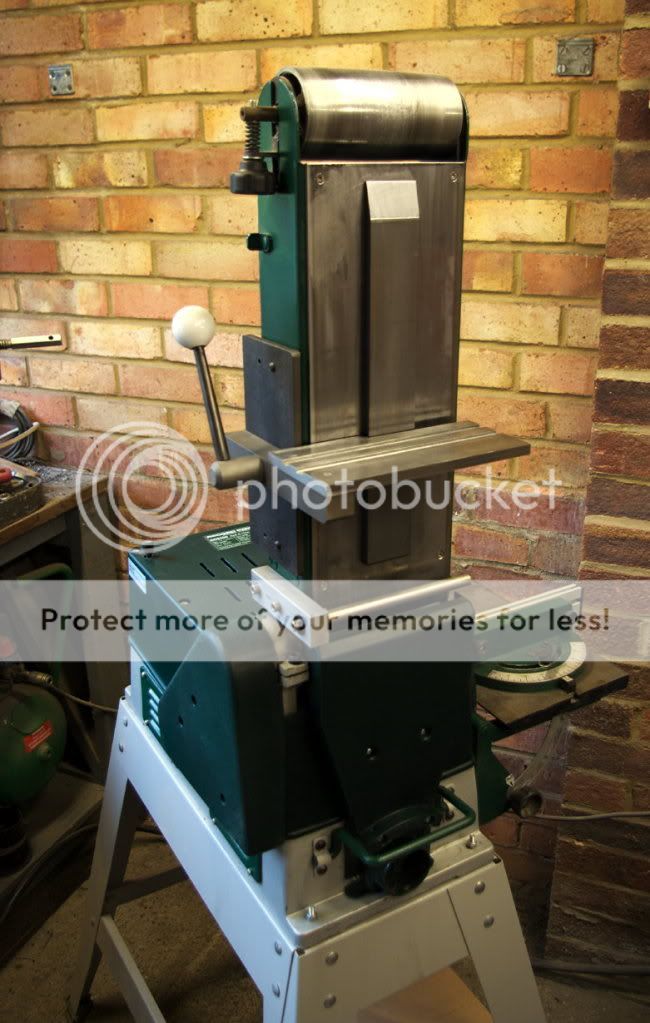You are using an out of date browser. It may not display this or other websites correctly.
You should upgrade or use an alternative browser.
You should upgrade or use an alternative browser.
More sharpening woes
- Thread starter Bigbud78
- Start date

Help Support UKworkshop.co.uk:
This site may earn a commission from merchant affiliate
links, including eBay, Amazon, and others.
Rhossydd
Established Member
Yes, you can build a vertical belt linisher for less.
What you miss is the quality build of the tool rests/jigs that makes different setting so accurate, easy and repeatable.
Plus they do hold their value rather better.
What you miss is the quality build of the tool rests/jigs that makes different setting so accurate, easy and repeatable.
Plus they do hold their value rather better.
sploo
Somewhat extinguished member
I'm a new turner (so new I don't even have a lathe). I sharpen plane irons and bevel edge chisels by hand, and so only have a really cheap and nasty grinder - with a very coarse (and fairly wobbly) wheel.
It occurs to me that at minimum I'll need a jig for the grinder (~£100) and probably a better wheel (e.g. an O'Donnell 'Ruby' at ~£20). If I did go for a decent grinder (Creusen?) I'm then looking at another couple of hundred notes.
So... is the obvious answer to just buy the ProEdge? It looks as though the Deluxe model contains everything I'd need for starters (Skew Jig, Fingernail Profiler and Standard Gouge Jig) with the exception of maybe a 60 grit belt for initial shaping?
It occurs to me that at minimum I'll need a jig for the grinder (~£100) and probably a better wheel (e.g. an O'Donnell 'Ruby' at ~£20). If I did go for a decent grinder (Creusen?) I'm then looking at another couple of hundred notes.
So... is the obvious answer to just buy the ProEdge? It looks as though the Deluxe model contains everything I'd need for starters (Skew Jig, Fingernail Profiler and Standard Gouge Jig) with the exception of maybe a 60 grit belt for initial shaping?
Dalboy
Established Member
sploo":1iyolu5k said:I'm a new turner (so new I don't even have a lathe). I sharpen plane irons and bevel edge chisels by hand, and so only have a really cheap and nasty grinder - with a very coarse (and fairly wobbly) wheel.
It occurs to me that at minimum I'll need a jig for the grinder (~£100) and probably a better wheel (e.g. an O'Donnell 'Ruby' at ~£20). If I did go for a decent grinder (Creusen?) I'm then looking at another couple of hundred notes.
So... is the obvious answer to just buy the ProEdge? It looks as though the Deluxe model contains everything I'd need for starters (Skew Jig, Fingernail Profiler and Standard Gouge Jig) with the exception of maybe a 60 grit belt for initial shaping?
You can have a set up at a fraction of the cost, as long as the grinder runs true get a decent wheel white or ruby then make your own jigs. That will be enough to start with no need to go expensive. Have a look at Brian Clifford's site for home made jigs to get you started Here is one
I know the Pro Edge brigade will tell you otherwise. But why spend money for the sake of it.
And then there are the "All the gear but no idea brigade" :lol: :lol: :lol:
sploo
Somewhat extinguished member
The current grinder is a bit... wobbly... so maybe not a good start. My problem is that I'm all the gear, no idea, and none of the time these days to build DIY jigs :wink: (though I will take a look at that site)Dalboy":1bk6blb9 said:You can have a set up at a fraction of the cost, as long as the grinder runs true get a decent wheel white or ruby then make your own jigs. That will be enough to start with no need to go expensive. Have a look at Brian Clifford's site for home made jigs to get you started Here is one
I know the Pro Edge brigade will tell you otherwise. But why spend money for the sake of it.
And then there are the "All the gear but no idea brigade" :lol: :lol: :lol:
I saw there's a long grind for the ProEdge and thought "Pah, if you've got the standard one and a lathe (and a drill press) you'd easily replicate that with a bit of hardwood or plastic". But it's a tenner... so I'd probably get it quicker by ordering one than finding the time to make one :|
Two of my mates are in different financial positions. I recommended the Pro Edge to one and having bought the deluxe version with all the bits he's over the moon with it. The other one simply couldn't afford to spend a large amount of money and already had a bench grinder. I suggested the Sorby 447 sharpening system to him and he's finding it quite easy to put an edge on his wood turning tools. Both now have sharp tools and I no longer get "can you just sharpen this for me" which I have to say I didn't actually mind anyway! :wink:
I should add that I don't just sharpen wood working tools on my rig and can also use it with a six inch wide belt for sanding wood. Cleaning between grinding wood and metal is a must though unless you like the smell of burning wood dust!

I should add that I don't just sharpen wood working tools on my rig and can also use it with a six inch wide belt for sanding wood. Cleaning between grinding wood and metal is a must though unless you like the smell of burning wood dust!

Rhossydd
Established Member
Totally agree.Dalboy":16kf8m45 said:I know the Pro Edge brigade will tell you otherwise. But why spend money for the sake of it.
A decent wheel and some home made jigs will get you set up to sharpen turning tools for a fraction of the price.
However if budget isn't an issue, yes go out and buy a SPE, you're unlikely to be disappointed and it does do a great job for hand tools too.
It's often repeated here that buying really good kit first time rarely disappoints in the long term and can actually save you money.
sploo
Somewhat extinguished member
Indeed. I buy budget occasionally for something I won't use much (my best score probably being a 9" angle grinder that was cheaper than one hire - it lasted 10 years). But, it's definitely worth spending just a bit extra on something decent (if you can) as it makes life so much easier.Rhossydd":39b1z0jh said:It's often repeated here that buying really good kit first time rarely disappoints in the long term and can actually save you money.
That's kinda my thinking with the ProEdge - I don't have that much time sadly, and messing about with homemade jigs (when I don't quite know what I'm trying to achieve in terms of the correct grind) vs just getting something that'll do it right out of the box is a relatively easy decision. Well, it would be if the ProEdge was £150 cheaper, but such is life.
CHJ
Established Member
Don't obsess about long grinds on bowl gouges, I went years before venturing along those Ellsworth and similar lines, and guess what mine have all migrated back to respectable sweep that's more than enough for my style of turning and materials handled.sploo":1kpe0gje said:...I saw there's a long grind for the ProEdge and thought "Pah, if you've got the standard one and a lathe (and a drill press) you'd easily replicate that with a bit of hardwood or plastic". But it's a tenner... so I'd probably get it quicker by ordering one than finding the time to make one :|
Some folks like turning with a long grind and it suits the bulk of their preferred forms, watch a lot of east European turners working and they will do the same things with hooked tools on a pull stroke, sort your turning style out and branch out on the more esoteric forms and grinds when you come up against an access problem or someone demonstrates and gives you personal hands on access to see if you can handle the tool/method.
I made a point only yesterday when turning to take a real note of which portion of the gouge edge I was actually using, more than 80% of the gouge edge, the swept back portion, was just providing clearance so had no need of a sharpening touch up during the whole session, just the front 20% that was doing the cutting.
(Does mean you have to be aware of changing profile an correct now and then to maintain clearance but the shape had no bearing on how I used the tool other than anti-catch clearance.)
Rhossydd
Established Member
+1 to that.CHJ":2y981g4j said:Don't obsess about long grinds on bowl gouges, I went years before venturing along those Ellsworth and similar lines, and guess what mine have all migrated back to respectable sweep that's more than enough for my style of turning and materials handled.
Sometimes too much information just confuses, rather than helps, when getting started.
The long grinds are often rather a handful (ie catch a lot) in inexperienced hands. Mastering, or at least getting competent with, 'normal' profiles is a good starting point.
duncanh
Established Member
The guy who was secretary/treasurer and general tool sharpener at our club wouldn't put a long grind on the bowl gouges of beginners because when you have a catch it can be huge. If you're just starting out better to learn on more standard grinds.
selectortone
Still waking up not dead in the morning
Here's my modest sharpening station. The Record Power grinder was, if memory serves, a penny under £60.00 on a Yandles sale day and the two jigs together were about £50.00 off ebay (they are on there regularly). I improved the tilting platform with a Bristol locking handle, again off ebay. I splashed out on a CBN wheel from Axminster (£105.00) after using one at my teacher's place but the two white wheels I had on there did a perfectly adequate job.
I do my bowl and spindle gouges on the CBN wheel and my scrapers on the white one. Skews I tend to sharpen by hand with a diamond hone; that way I don't disturb the scraper angle on the platform. I was a guitar builder/repairer before I retired so I'm used to sharpening flat chisels by hand.
So, I'm into that lot for a little over two hundred quid, half of which was for the not totally essential but absolutely fabulous CBN wheel. The important thing as far as I'm concerned is that the rig is right at my elbow when I'm turning and putting a quick edge on a tool is very easy and quick. There's nothing worse than fannying about with ancillary gear when all you want to do is turn.

I do my bowl and spindle gouges on the CBN wheel and my scrapers on the white one. Skews I tend to sharpen by hand with a diamond hone; that way I don't disturb the scraper angle on the platform. I was a guitar builder/repairer before I retired so I'm used to sharpening flat chisels by hand.
So, I'm into that lot for a little over two hundred quid, half of which was for the not totally essential but absolutely fabulous CBN wheel. The important thing as far as I'm concerned is that the rig is right at my elbow when I'm turning and putting a quick edge on a tool is very easy and quick. There's nothing worse than fannying about with ancillary gear when all you want to do is turn.

duncanh":7btc2t9k said:To all you pro edge users - have you had a problem getting a long swept back grind? Last time I saw Martin Pidgeon he said that there was an issue with the Proedge which meant that some grinds were difficult/impossible to do on the machine. This includes one of the grinds that he prefers and would probably include several of mine.
Any thoughts?
Just seen this, no problem on even extra long grinds:
https://youtu.be/k-nTHpfcwkQ
Robbo3
Established Member
I notice on the Youtube video that woodpig posted that the pro-set jig gave the grind angle rather than the amount the gouge protrudes.
Could anyone post the relevant measurements for each angle, please.
Could anyone post the relevant measurements for each angle, please.
CHJ
Established Member
Robbo3":2ultmai7 said:Could anyone post the relevant measurements for each angle, please.
On my setup and for the grinds I prefer I do not use the ProEdge tool extension difference to change angles.
I set my Gouges at 50mm extension with a drop in block which is easier to use and adjust the nose angle with the extended pivot block, this also aids in better tool swing clearance for the level of swept back wings I personally prefer.
The original ProEdge settings for differing nose angles with the short pivot block were as far as I know:-
Head set at 120deg.
35 degrees, 112mm
40 degrees, 84mm
45 degrees, 62mm
50 degrees, 44mm
Sorry for the disjointed edits, someone decided to pull the plug at the exchange for an hour.
J-G
Established Member
Essentially - No - because the protrusion depends not only on the angle but also the diameter of the gouge and the distance from the belt to the jig guide (Vee block)Robbo3":16g7wayu said:I notice on the Youtube video that woodpig posted that the pro-set jig gave the grind angle rather than the amount the gouge protrudes.
Could anyone post the relevant measurements for each angle, please.
I can tell you the protrusion per mm from belt to guide ...
15º - 3.73
30º - 1.73
45º - 1
60º - 0.577
... but this doesn't tell you the whole story since the gouge diameter will affect the distance as well.
It will be easy to measure the distance from the belt to the bottom of the Vee block and I can give you the distance from the bottom of the Vee to the centre of the gouge based upon the gouge diameter (assuming a standard 90º Vee) ...
12mm Ø - 8.48
15mm Ø - 10.6
18mm Ø - 12.73
20mm Ø - 17.77
... you will then need to add the height of the gouge from the centre-line to the top - which I'm sure you will appreciate will change depending upon the orientation - ie. as you rotate the gouge clock-wise or anti.
Given a 12mm Gouge with a thickness of (say) 10mm, a belt to bottom of Vee distance of (say) 20mm - we can calculate that the top of the gouge at the lowest point will be 20 + 8.48 + 4 = 32.48mm above the belt at the front of the Vee Block. Assuming you want a 30º grind then the protrusion will be 32.48 x 1.73 = 56.19mm.
Whether this is any benefit to you or not I cannot say but I hope it can show you how the protrusion is affected by many factors and can be derived.
I don't use a ProEdge (so don't know specific dimensions) or any other form of linisher based grinding aid - I do all my sharpening by hand on a 6" grinder as I was taught by my father and apprentice supervisor(s) many years ago
Robbo3
Established Member
Thanks gents.
Apologies for hijacking the thread.
I can add that 60° requires a 30mm protrusion on a standard fingernail grind.
I found this by setting the table to 60° & rolling the tool for a straight across grind ie, non fingernail, then transferring the gouge to the gouge holder, covering the tip with marker pen & adjusting the protrusion until a complete line of ink was removed. Probably not the most scientific method but hopefully accurate enough to suffice.
Apologies for hijacking the thread.
I can add that 60° requires a 30mm protrusion on a standard fingernail grind.
I found this by setting the table to 60° & rolling the tool for a straight across grind ie, non fingernail, then transferring the gouge to the gouge holder, covering the tip with marker pen & adjusting the protrusion until a complete line of ink was removed. Probably not the most scientific method but hopefully accurate enough to suffice.
Robbo3
Established Member
woodpig":3klmjlnn said:I thought the idea on the video of flattening the gouge first was a good idea.
I agree. It's not knowing what shape to aim for that causes confusion.
More on different grinds for different flute shapes,
- http://www.peterchild.co.uk/info1/sflute.htm
- http://www.woodcentral.com/newforum/grinds.shtml
& some Youtube
- Bob Hamilton (standard to side grind) - https://www.youtube.com/watch?v=AAocVE7X_3U
- LJ - http://www.youtube.com/watch?v=0zUph9zEjck (http://www.youtube.com/watch?v=3liDhY_zxSc)
- Dan Douthart (Gwinnett 1h30m) - https://www.youtube.com/watch?v=v0iuJgg7zus
Bigbud78
Established Member
Thanks for all the discussion, been away for a few weeks and have still not made my mind up but found an idea for a tool to setup the jig I have so might give that a go before I decide.
The PE is still the front runner though with a CBN wheel and better jigs in 2nd
The PE is still the front runner though with a CBN wheel and better jigs in 2nd
Similar threads
- Replies
- 19
- Views
- 2K
Latest posts
-
-
-
-
-
making simple unfinished wood picture frames - what set up for a newbie?
- Latest: Trextr7monkey
-
-
-




